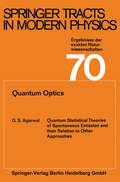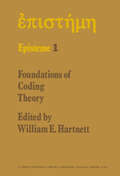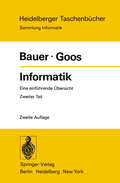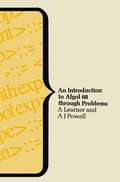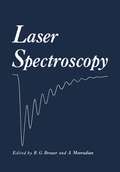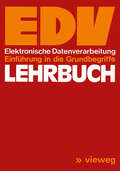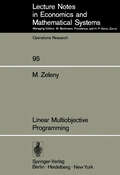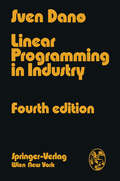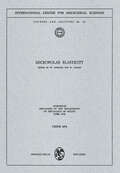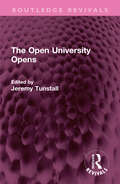- Table View
- List View
Computer Aided Automatic Design: Course held at the Department of General Mechanics, October 1972 (CISM International Centre for Mechanical Sciences #155)
by C. Bona C. Galletti A. LucifrediCooperative and Non-Cooperative Many Players Differential Games: Course Held at the Department of Automation and Information July 1973 (CISM International Centre for Mechanical Sciences #190)
by George LeitmannFoundations of Coding Theory (Episteme #1)
by W. E. HartnettDuring the sixteenth century, Cardano wrote a fascinating work called The Book on Games of Chance. In it he gives an extremely candid recount ing and personal appraisal of some aspects of his most remarkable life. * One feature of the book is striking for the modern scientist or mathemati cian accustomed to current publishing practices. It is brought out during Cardano's discussion of his investigations of certain special questions of applied probability, namely, the question of how to win at gambling. His technique is simplicity itself: in fine reportorial style he reveals his proposed strategy for a particular gambling game, giving marvelous motivating arguments which induce the reader to feel warm, heartfelt support for the projected strategy. Then with all the drama that only a ringside seat observation can bring, Cardano announces that he tried the strategy at the casino and ended up borrowing his taxi fare. Undaunted by failure, he analyzes his now fire-tested strategy in detail, mounts new and per suasive arguments, and, ablaze with fresh optimism and replenished resources, charges off to the fray determined to now succeed where he had so often failed before. Along the way, Cardano developed a number of valuable insights about games of chance and produced useful research results which presumably would be of interest in our present-day society. However, he could never publish the results today in journals with all the flair, the mistakes, the failures and minor successes which he exhibits in his book.
Informatik: Eine einführende Übersicht Zweiter Teil (Heidelberger Taschenbücher #91)
by F. L. Bauer G. GoosLaser Spectroscopy
by Richard BrewerThe Laser Spectroscopy Conference held at Vail, Colorado, June 25-29, 1973 was in certain ways the first meeting of its kind. Var ious quantum electronics conferences in the past have covered non linear optics, coherence theory, lasers and masers, breakdown, light scattering and so on. However, at Vail only two major themes were developed - tunable laser sources and the use of lasers in spectro scopic measurements, especially those involving high precision. Even so, Laser Spectroscopy covers a broad range of topics, making possible entirely new investigations and in older ones orders of magnitude improvement in resolution. The conference was interdisciplinary and international in char acter with scientists representing Japan, Italy, West Germany, Canada, Israel, France, England, and the United States. Of the 150 participants, the majority were physicists and electrical engineers in quantum electronics and the remainder, physical chemists and astrophysicists. We regret, because of space limitations, about 100 requests to attend had to be refused.
Lehrbuch EDV: Elektronische Datenverarbeitung Einführung in die Grundbegriffe
by Roswitha EngelbrechtLinear Multiobjective Programming (Lecture Notes in Economics and Mathematical Systems #95)
by M. Zeleny1.1. The origin of the multiobjective problem and a short historical review The continuing search for a discovery of theories, tools and c- cepts applicable to decision-making processes has increased the complexity of problems eligible for analytical treatment. One of the more pertinent criticisms of current decision-making theory and practice is directed against the traditional approximation of multiple goal behavior of men and organizations by single, technically-convenient criterion. Reins- tementof the role of human judgment in more realistic, multiple goal se,ttings has been one of the ma~or recent developments in the literature. Consider the following simplified problem. There is a large number of people to be transported daily between two industrial areas and their adjacent residential areas. Given some budgetary and technological c- straints we would like to determine optimal transportation modes as well as the number of units of each to be scheduled for service. What is the optimal solution? Are we interested in the cheapest transportation? Do we want the fastest, the safest, the cleanest, the most profitable, the most durable? There are many criteria which are to be considered: travel times, consumer's cost, construction cost, operating cost, expected fatalities and injuries, probability of delays, etc.
Linear Programming in Industry: Theory and Applications An Introduction
by Sven DanoA. Planning Company Operations: The General Problem At more or less regular intervals, the management of an industrial enter prise is confronted with the problem of planning operations for a coming period. Within this category of management problems falls not only the overall planning of the company's aggregate production but problems of a more limited nature such as, for example, figuring the least-cost combina tion of raw materials for given output or the optimal transportation schedule. Any such problem of production planning is most rationally solved in two stages: (i) The first stage is to determine the feasible alternatives. For example, what alternative production schedules are at all compatible with the given capacity limitations? What combinations of raw materials satisfy the given quality specifications for the products? etc. The data required for solving this part of the problem are largely of a technological nature. (ii) The second is to select from among these alternatives one which is economically optimal: for example, the aggregate production programme which will lead to maximum profit, or the least-cost combination of raw materials. This is where the economist comes in; indeed, any economic problem is concerned with making a choice be.tween alternatives, using some criterion of optimal utilization of resources.
Matrix Eigensystem Routines - EISPACK Guide (Lecture Notes in Computer Science #6)
by B.T. Smith J.M. Boyle B.S. Garbow Y. Ikebe V.C. Klema C.B. MolerMaximum Probability Estimators and Related Topics (Lecture Notes in Mathematics #424)
by L. Weiss J. WolfowitzMicropolar Elasticity: Symposium Organized by the Department of Mechanics of Solids, June 1972 (CISM International Centre for Mechanical Sciences #151)
by W. Nowacki W. OlszakNC-Programmierung: Rechnerunterstützte Auswahl von Fräswerkzeugen (ISW Forschung und Praxis #11)
by J. WaelkensThe Open University Opens (Routledge Revivals)
by Jeremy TunstallStill going strong today, The Open University, Britain’s national correspondence – TV – radio University, excited much controversy when it first opened and in 1973 awarded its first degrees. With its adult, part-time students, its freedom from formal entrance qualifications, it deliberately questioned many orthodoxies of higher education at the time. Yet the OU differed so much from other universities that few outsiders grasped quite how complex, quite how revolutionary, quite how downright infuriating the OU was, or could be.Originally published in 1974, this book gives a first-hand account of what the OU was about and what it felt like to be an OU student or lecturer. The articles in the collection – edited by Jeremy Tunstall, himself on the OU staff – include contributions from outside observers, from OU staff, and from OU students. This is an unofficial yet informed and lively account of what it felt like in 1974, and what it felt like in the early days, to be part of a project so controversial and progressive.
The Open University Opens (Routledge Revivals)
Still going strong today, The Open University, Britain’s national correspondence – TV – radio University, excited much controversy when it first opened and in 1973 awarded its first degrees. With its adult, part-time students, its freedom from formal entrance qualifications, it deliberately questioned many orthodoxies of higher education at the time. Yet the OU differed so much from other universities that few outsiders grasped quite how complex, quite how revolutionary, quite how downright infuriating the OU was, or could be.Originally published in 1974, this book gives a first-hand account of what the OU was about and what it felt like to be an OU student or lecturer. The articles in the collection – edited by Jeremy Tunstall, himself on the OU staff – include contributions from outside observers, from OU staff, and from OU students. This is an unofficial yet informed and lively account of what it felt like in 1974, and what it felt like in the early days, to be part of a project so controversial and progressive.
Optimal Control Theory (Applied Mathematical Sciences #12)
by L.D. BerkovitzThis book is an introduction to the mathematical theory of optimal control of processes governed by ordinary differential eq- tions. It is intended for students and professionals in mathematics and in areas of application who want a broad, yet relatively deep, concise and coherent introduction to the subject and to its relati- ship with applications. In order to accommodate a range of mathema- cal interests and backgrounds among readers, the material is arranged so that the more advanced mathematical sections can be omitted wi- out loss of continuity. For readers primarily interested in appli- tions a recommended minimum course consists of Chapter I, the sections of Chapters II, III, and IV so recommended in the introductory sec tions of those chapters, and all of Chapter V. The introductory sec tion of each chapter should further guide the individual reader toward material that is of interest to him. A reader who has had a good course in advanced calculus should be able to understand the defini tions and statements of the theorems and should be able to follow a substantial portion of the mathematical development. The entire book can be read by someone familiar with the basic aspects of Lebesque integration and functional analysis. For the reader who wishes to find out more about applications we recommend references [2], [13], [33], [35], and [50], of the Bibliography at the end of the book.
Österreichische Verfassungs- und Verwaltungsgeschichte: Ein Lehrbuch für Studierende (Rechts- und Staatswissenschaften #13)
by Ernst C. HellblingEiner Anregung von Herrn UniversWitsprofessor Dr. Alfred Ve r d r 0 s s folgend, habe ieh dieses Bueh verfaBt, das in erster Linie dem langgefuhlten Mangel eines modernen, fiir den Studierenden bestimm ten Lehrbuehes del' Osterreiehisehen Verfassungs- und Verwaltungs geschiehte abhelfen solI, daruber hinaus abel' fiir einen groBeren Kreis von Juristen, Historikern und Politikern best,immt ist, die sieh einen Uberbliek iiber die reehtsgesehichtliche Entwieklung der Verfassung und Verwaltung in Osterreieh bis in die neueste Zeit versehaffen wollen. Urn den Text nieht zu sehr zu belasten, sind die Angaben uber das Sehriftturp kurz gehalten, jedoch wurde ein umfangreiehes, wenn aueh durchaus nieht vollstandiges Literaturverzeiehnis aufgenommen. Da die Anfiihrung aller einsehlagigen Monographien kaum moglieh ge wesen ware, wurde eine Zusammenstellung del' wichtigsten Zeitsehrif ten beigegeben, aus denen solche Monographien zu ersehen sind. Die bewahrten Lehrbueher wie der GrundriB del' Osterreiehisehen Reichs gesehichte von L usc h i n, die osterreiehisehe Reiehsgesehiehte von Hub e r Do - p s e h, die zweibandige Geschiehte osterreichs von Han t s e h und fiir die Zeit seit 1848 auBerdem noch das osterreiehi sehe Staatsreeht von K el sen und der GrundriB des osterreiehischen Verfassungsreehts von A dam 0 vic h waren mil' auBerordentlieh wert volle Grundlagen und fanden deshalb weitgehende Beriieksiehtigung. Aueh an dem GrundriB del' Osterreiehisehen Verfassungs- und Ver waltungsgesehiehte von S t 0 I z konnte nieht vorubergegangen werden. Die Einteilung des Stoffes in Zeitperioden, wie sie den meisten Buehern historisehen lnhalts zugrunde liegt, sehien aueh mil' zweekmaBig.
PASCAL - User Manual and Report (Lecture Notes in Computer Science #18)
by K. Jensen N. WirthThis manual is directed to those who have previously acquired some programming skill. The intention is to provide a means of learning Pascal without outside guidance. It is based on !he Prpgramming ~angyage e~ (Bev1sed B~) [1]--the basic definition of Pascal and concise reference manual for the experienced Pascal programmer. The linear structure of a book is by no means ideal for introducing a language, whether it be a formal or natural one, Nevertheless, it is recommended to follow the given organiZation, paying particular attention to the example programs, and then to reread those sections causing difficultes. One may wish, however, to reference chapter 12 if troubles arise concerning the input and output conventions of the programs. The manual was prepared as a file on a computer, that is , as a sequence of characters of a single type font. This is very convenient for the purposes of updating: unfortunately, it is sometimes a bit awkward to read. The reader is asked to be indulgent with the absence of sub- and superscripts (e.g. m raised to the power n is denoted by m**n).
Recognition of Patterns: Using the frequencies of Occurrence of Binary Words
by Peter W. BeckerThe work described in this publication was initiated at the General Electric Company's Electronics Laboratory, Syracuse, N.Y., U.S.A. The author would like to take this opportunity to express his gratitude to the Electronics Laboratory for its support and encouragement in this work. Thanks are in particular due to Mr. J.J. Suran for his continued interest and help. It is impossible to acknowledge all the help the author has re ceived from members of the Laboratory staff. However, the author is par ticularly indebted to Mr. T.C. Robbins for managing the building of the word recognizer (described in Section 7.4) and for many helpful discussions. Thanks are also due to Mr. W.E. Sollecito for valued support and direction, and to S.M. Korzekwa, S.B. Akers, Jr., and B.L. Crew for many discussions on implementation and design of pattern recognizers. Part of the work has been sponsored by two departments of the General Electric Company, the Large Jet Engine Department and the Apollo Support Department. The author is grateful for the permission from the two departments to publish results of theoretical interest in this dissertation. The work was later continued in Denmark, supported by two grants: no.
Sensation and Measurement: Papers in Honor of S. S. Stevens
by H. R. Moskowitz B. Scharf J. C. StevensWe planned this book as a Festschrift for Smitty Stevens because we thought he might be retiring around 1974, although we knew very well that only death or deep illness would stop Smitty from doing science. Death came suddenly, unexpectedly - after a full day of skiing at Vail, Colorado on the annual trip with wife Didi to the Winter Conference on Brain Research. Smitty liked winter conferences near ski resorts and often tried to get us other psychophysicists to organize one. Every person is unique. Smitty would have said it's mainly because each of us has so many genes that two combinations just alike would be well-nigh impossible. But most of us strive in many ways to be like others, and to abide by the norms (some smaller number try even harder to be unlike other people); as a result many persons seem to lose their uniqueness, their individuality. Not Smitty. He tried neither to be like others nor to be different. He took himself as he found himself, and ascribed peculiarities, strengths, and weaknesses to his pioneering Utah forebears, in whom he took much pride. His was the true and right nonconformity. He approached each task, each problem, ready to grapple with the facts and set them into meaningful order. And if the answer he came up with was different from everyone else's, well that was too bad.
Taschenbuch der Informatik: Band III: Anwendungen und spezielle Systeme der Nachrichtenverarbeitung
by T. HeinemannSeit der letzten Auflage des von K. Sleinbuck herausgegebenen Taschenbuchs der Nachrichtenverarbeitung im Jahre 1967 war eine Überarbeitung dieses Werkes wiederum dringend notwendig geworden, um die dynamische Entwicklung dieses Gebietes in einem "Zeitschnitt" einzufangen. Autoren, Herausgeber und Verlage solcher Werke leiden wie diese selbst natürlich unter dem Zwang, ein in Bewegung befindliches Gebiet immer nur in gewissen Zeitabständen darstellen zu können, zumal bei der Drucklegung manche Beiträge schon wieder ergänznngsbedürftig sind, aus verlegerischen und organisa torischen Gründen jedoch die Festlegung. eines rechtzeitigen Abgabetermines erforderlich ist, gerade bei einem derart umfangreichen Unternehmen mit dieser großen Anzahl VOn Einzelautoren. Nach wie vor war das Ziel bei der Gestaltung dieses Nachfolgers des Taschen buchs der Nachrichtenverarbeitung, ein Nachschlagewerk für die Grundlagen und die Technik der Nachrichtenverarbeitung zu schaffen, das dem Ingenieur, System analytiker, Organisationsfachmann, Informatiker, Mathematiker und Physiker eine rasche Übersicht schafft, die wichtigsten Tatsachen unmittelbar darstellt und für spezielle Fragen Quellenhinweise gibt. In dieser Hinsicht ist der Charakter des ursprünglichen Werkes gewahrt ge blieben. Gänzlich neu ist jedoch die begriffliche Gliederung des Gesamtstoffes und die Aufnahme neuer Themenkomplexe und damit die Beteiligung zusätzlicher Autoren für Einzelbeiträge, wobei eine Reihe früherer Beiträge aus Gründen der Beschränkung auf einen vernünftigen Umfang fortgelassen oder gekürzt werden mußten. Neu hinzugekommen sind insbesondere größere Abschnitte über die Program mierung und über die Anwendung von EDV-Systemen.
Taschenbuch der Informatik: Band II Struktur und Programmierung von EDV-Systemen
by T. HeinemannSeit der letzten Auflage des von J(.Steinbuch herausgegebenen Taschenbuchs der Nachrichtenverarbeitung im Jahre 1967 war eine Überarbeitung dieses Werkes wiederum dringend notwendig geworden, um die dynamische Entwicklung dieses Gebietes in einem "Zeitschnitt" einzufangen. Autoren, Herausgeber und Verlage solcher Werke leiden wie diese selbst natürlich unter dem Zwang, ein in Bewegung befindliches Gebiet immer nur in gewissen Zeitabständen darstellen zu können, zumal bei der Drucklegung manche Beiträge schon wieder ergänzungsbedürftig sind, aus verlegerischen und organisa torischen Gründen jedoch die Festlegung eines rechtzeitigen Abgabetermines erforderlich ist, gerade bei einem derart umfangreichen Unternehmen mit dieser großen Anzahl von Einzelautoren. Nach wie vor war das Ziel bei der Gestaltung dieses Nachfolgers des Taschen buchs der Nachrichtenverarbeitung, ein Nachschlagewerk für die Grundlagen und die Technik der Nachrichtenverarbeitung zu schaffen, das dem Ingenieur, System analytiker, Organisationsfachmann, Informatiker, Mathematiker und Physiker eine rasche Übersicht schafft, die wichtigsten Tatsachen unmittelbar darstellt und für spezielle Fragen Quellenhinweise gibt. In dieser Hinsicht ist der Charakter des ursprünglichen Werkes gewahrt ge blieben. Gänzlich neu ist jedoch die begriffliche Gliederung des Gesamtstoffes und die Aufnahme neuer Themenkomplexe und damit die Beteiligung zusätzlicher Autoren für Einzelbeiträge, wobei eine Reihe früherer Beiträge aus Gründen der Beschränkung auf einen vernünftigen Umfang fortgelassen oder gekürzt werden mußten. Neu hinzugekommen sind insbesondere größere Abschnitte über die Program mierung und über die Anwendung von EDV-Systemen.



